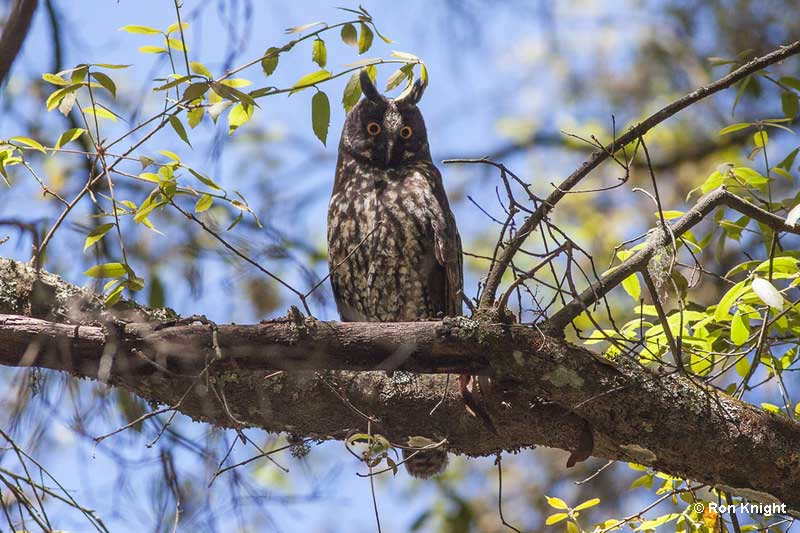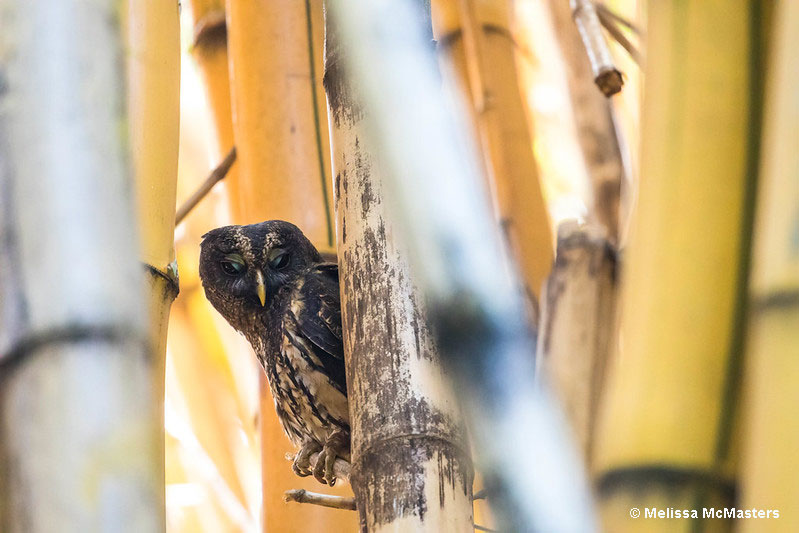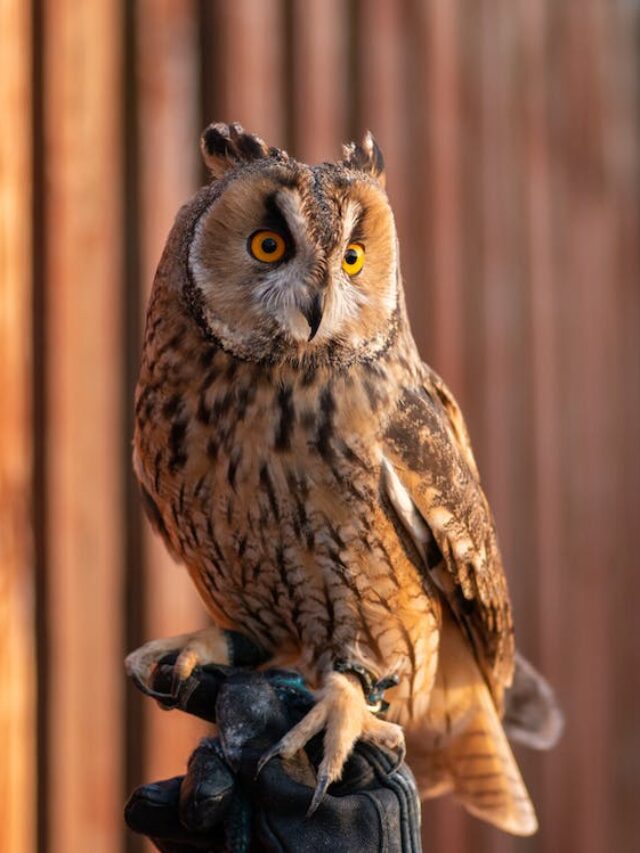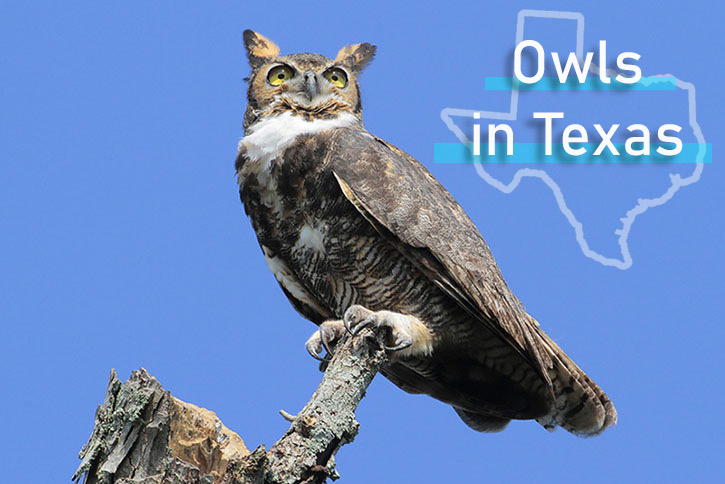
Which owls live in Texas? More than most people realize! Several owls are actually common birds in Texas.
However, we don’t see them so often because most only come out at night and hide during the day. Even so, we see them once in a while, in every part of the state.
Which owls have you seen in Texas? See this article to learn about and identify these special birds!
Most Common Owls in Texas
According to eBird data, there are nine species of owls commonly seen in Texas. However, eight other local and rare species of owls have also occurred in the state. With luck, you might see some of these rare owls too!
To help identify the owls of Texas, our list included identification tips and other information about these unique birds. We have arranged the most common owls first and the least common ones last.
Great Horned Owl
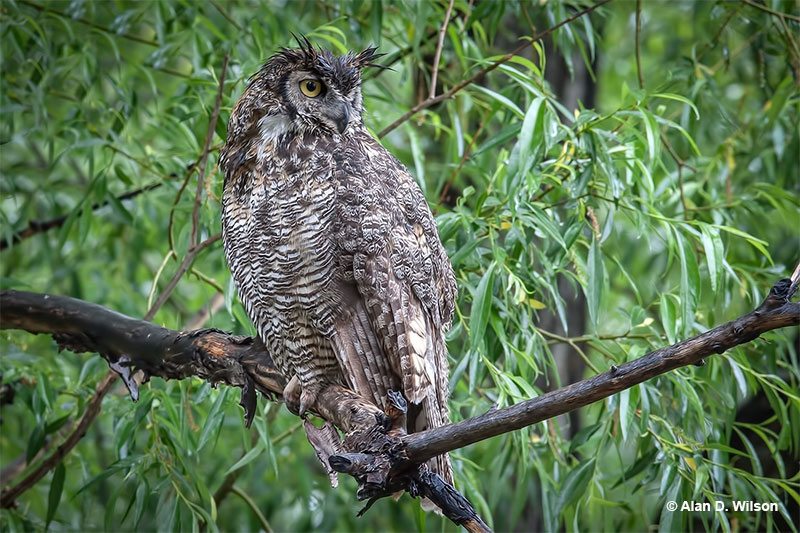
- Range: Permanent resident in much of Alaska, Canada, and the USA.
- Length: 22 inches
- Wingspan: 44 inches
- Call: Makes a low, gruff, “hooo, hoo hoo hoo hoooo”.
The Great Horned Owl is a big, bulky owl with big ear tufts and a black beak. It is mottled gray and brown, has a rufous or gray face, and fine black barring on its underparts. This owl also has a white throat and some dark marks on its breast.
Males and female Great Horned Owls look the same but females are larger. They also have a medium-length tail with dark bands, and long, broad wings.
This nocturnal owl species lives in every possible habitat, including urban areas.
Key Identifications:
- Big, bulky brown or gray owl with ear tufts and fine barring on its underparts.
- Nests in old stick nests of other large birds, on ledges, and in other situations.
- Watches from a perch or glides over open habitats at night, to catch mammals and some birds on the ground.
Barred Owl
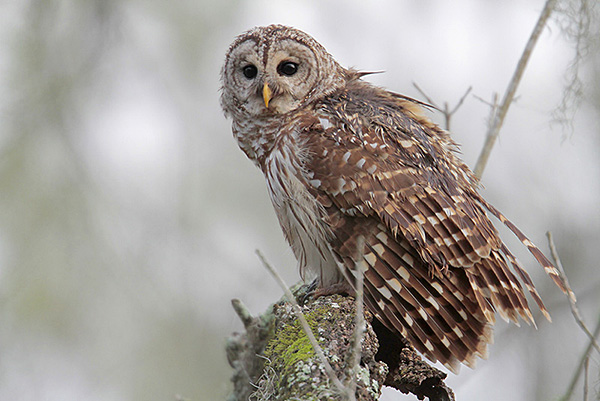
Photograph © Greg Lavaty.
- Range: A permanent resident in most forested areas in Canada, parts of some Pacific Northwestern states, and most of the eastern USA.
- Length: 21 inches
- Wingspan: 42 inches
- Call: Makes loud hooting and caterwalling sounds, “Who cooks for you?! Who cooks for youaaaal!”
The Barred Owl is a medium to large owl with a round head and a narrow black border on its pale gray face. It has dark brown upperparts with white markings, and dark brown streaks on its belly.
This species also has a yellowish beak and dark eyes. Both sexes look the same except that females are a bit larger than males.
The Barred Owl flaps and glides on big, broad wings. It also has a medium-length, broad tail with a few dark brown bands.
Key Identifications:
- Big owl with a round head that has white marks on dark brown upperparts, and dark brown streaks on pale underparts.
- Perches and swoops through wooded areas at night but can also be active in the day.
- Nests in tree cavities and in abandoned nests of crows and hawks.
- Catches a wide variety of small animals.
Eastern Screech-Owl
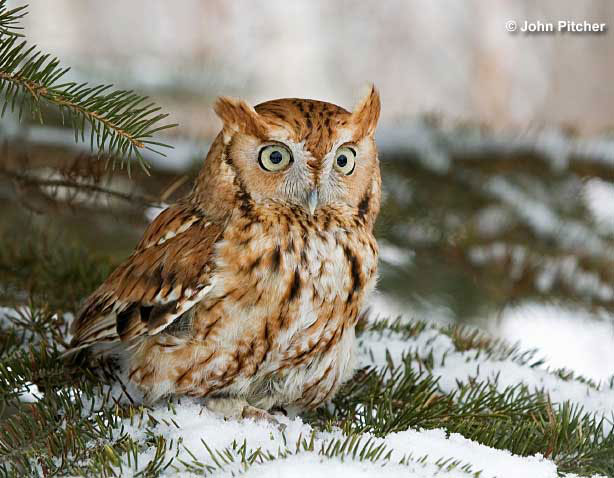
- Range: Permanent resident in parts of southeastern Canada, and in much of the eastern USA.
- Length: 8.5 inches
- Wingspan: 20 inches
- Call: Makes a rather high-pitched, descending whinny call, and a tremulous, vibrating call on the same pitch, “wududududududududududu”.
The Eastern Screech Owl is a small owl with ear tufts. It can be reddish, brown, or mostly gray, has “V”-shaped pale eyebrows, and some black on the edge of its face. It is also mottled above with some white spotting, and has pale underparts with dark barring and streaks.
Males and females look alike but females are a bit larger. This species also has yellow eyes, a pale yellow-gray beak, and some white bands on its broad tail.
Eastern Screech-Owls flap and glide on long, broad wings.
During the day, this owl hides in holes, or in dense vegetation. Eastern Screech Owls are common owls in Texas.
Key Identifications:
- Small owl with ear tufts and mottled brown or gray plumage that lives east of the Rocky Mountains.
- Lives in a variety of wooded and park-like habitats.
- Nests in tree cavities and nest boxes.
- Swoops down to the ground catch a variety of small animals at night.
Related: The 30 Most Common Birds of Texas
Burrowing Owl
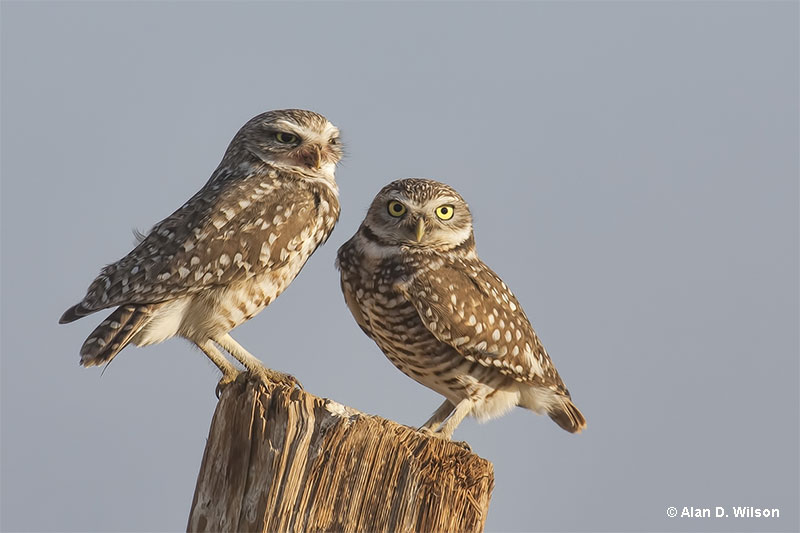
© Alan D. Wilson
- Range: Summer resident in central-southern Canada, the Great Plains, and much of the western USA. Permanent resident in California, Texas, and Florida.
- Length: 9.5 inches
- Wingspan: 21 inches
- Call: Makes a raspy, chattering call, “rap, rip,rip,rip,rip”, and a quail-like, “whup waaah!”.
The Burrowing Owl is a small, long-legged owl with a white throat and white eyebrows. It has a round head, is dark brown with white spots above, and has pale underparts with dark barring.
Males and females look alike, although females are a bit larger. Young birds are uniform dark brown and buff.
Adult Burrowing Owls in Florida are more heavily marked below than western birds but juveniles from Florida are paler.
The Burrowing Owl is active day and night in grasslands, deserts, and other open habitats. Burrowing Owls are one of the most common owl species in Texas.
Key Identifications:
- Small, long-legged owl with a round head, and some brown barring on pale underparts.
- Lives in grasslands and other wide-open habitats.
- Nests in burrows made by prairie dogs and other animals although birds in Florida make their own burrows.
- Catch small animals on the ground at any time of the day or night.
Barn Owl
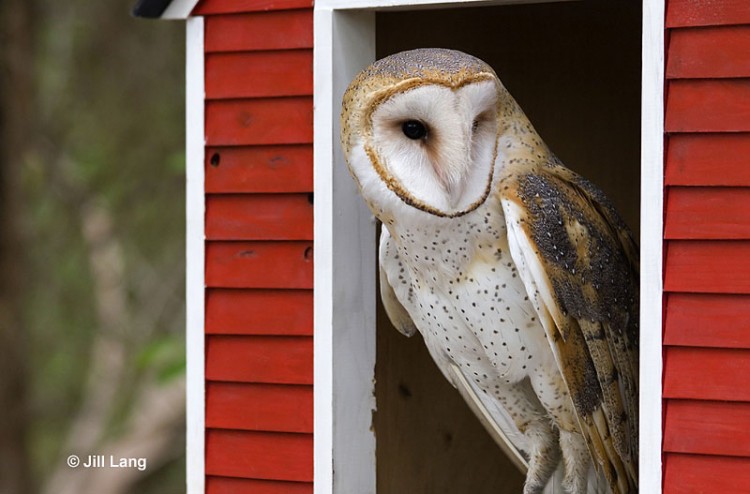
- Range: In Canada, occurs mostly in southwestern British Columbia. In the USA, they live in many areas but are absent from mountains and cold, northern regions. They range north to Washington, Nebraska, Iowa, and New York.
- Length: 16 inches
- Wingspan: 42 inches
- Call: A shrill, loud, hissing “shriiiiii!”
The Barn Owl is a medium to large, pale owl with golden tan and gray upperparts, and white underparts. It has a distinctive, white, heart-shaped face.
Both sexes are alike but females are a bit larger than males and have buff on their chest.
In flight, Barn Owls look like a large, pale, moth-like bird with a big, rounded head.
Related: Do you know what a group of owls is called?
This owl hunts in grasslands, farms, and other open habitats.
Key Identifications:
- Large pale owl with a heart-shaped face.
- Glides and flutters over fields and other open areas at night.
- Nests in tree cavities, crevices in church steeples and other structures, and next boxes.
- Preys on rats and other small animals.
Elf Owl
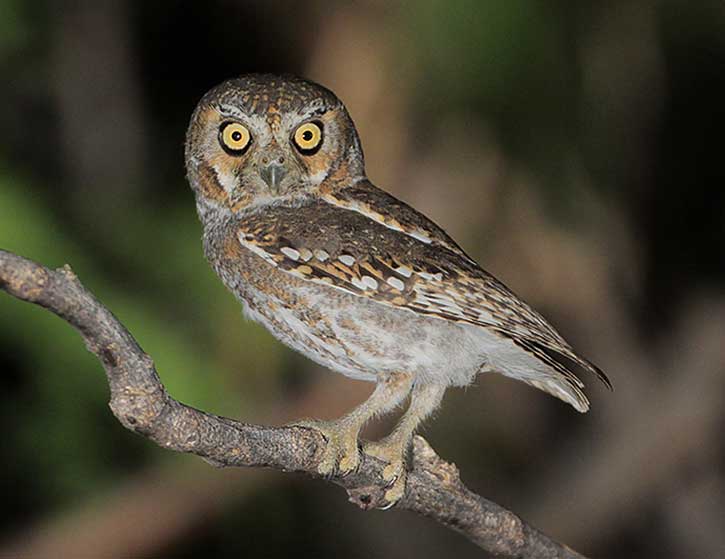
- Range: Summer resident in parts of Arizona, New Mexico, and southern Texas.
- Length: 5.75 inches
- Wingspan: 13 inches
- Call: Makes rising and descending yipping calls, “kup kip,kip,kip,kip,kup”.
The Elf Owl is a tiny, sparrow-sized owl with a round head and yellow eyes. It is soft gray and brown and has a plain brown face with white eyebrows. It also has white wing bars, and some thick brown streaks below.
Males and females look the same although females are a bit larger. They also have yellow eyes, a dark beak, and fairly long, feathered legs and toes.
This species migrates to Mexico for the winter.
Key Identifications:
- Tiny brown and gray owl with a round head and pale underparts with a few thick blurry streaks.
- Lives in desert habitats and evergreen woodlands up to 6,000 feet in elevation.
- Nests in cavities in trees, wooden telephone poles, and saguaro cactus.
- Catches insects and small animals at night, in flight, on the ground, and in foliage.
Short-eared Owl
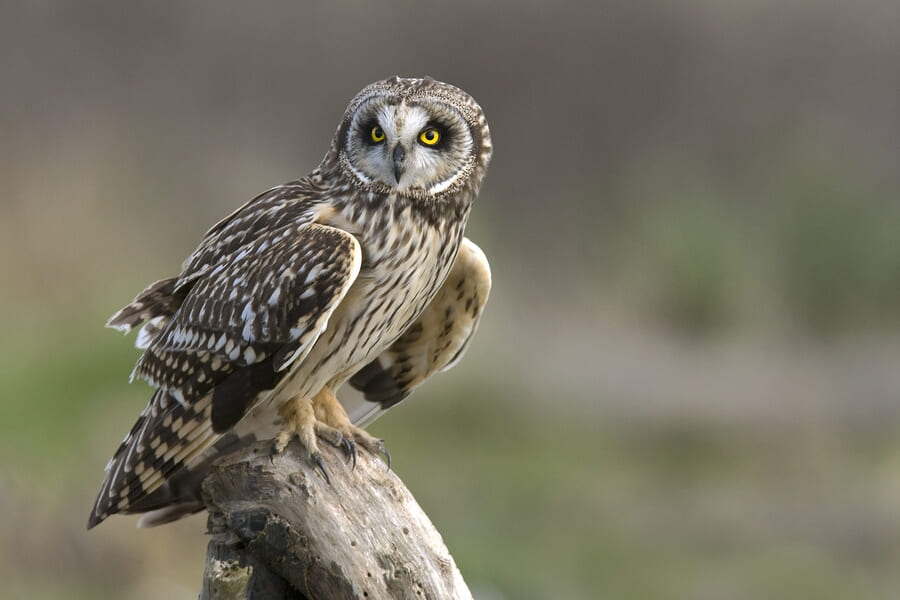
- Range: Summer resident in Alaska, Canada, and the western and central USA. Northern birds migrate to the USA, south to California and Texas.
- Length: 15 inches
- Wingspan: 38 inches
- Call: Makes a hoarse, raspy, cat-like call, “rehw”.
The Short-eared Owl is a medium-sized, pale brown owl with dark eye patches on a pale face. They have a dark breast and streaks on pale underparts. This species has long wings with buff wing patches.
Both sexes look similar but females are a bit larger and usually darker and buffier.
This owl is active day and night in open fields.
Key Identifications:
- Medium-sized pale brown and buffy owl with very short ear tufts.
- Dark eye patches on a pale face and long wings with buff patches near the wingtips.
- Nests on the ground in dense vegetation.
- Glides over open fields to catch small animals on the ground.
Long-eared Owl
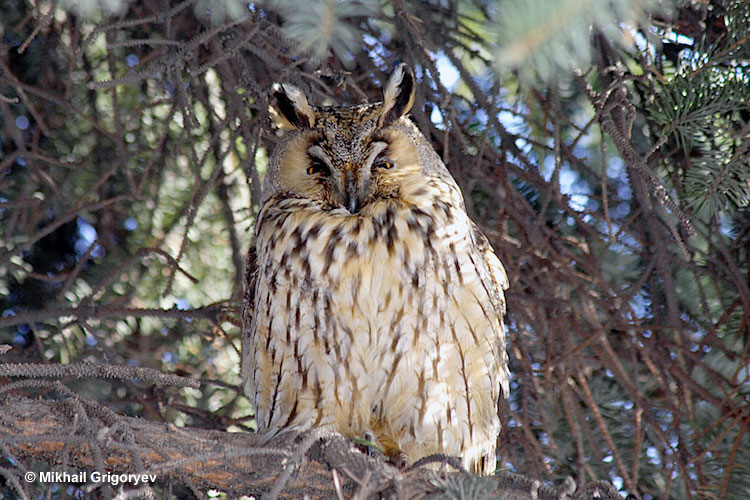
- Range: Migrant in southern Canada, resident and winters in much of the USA. Absent from parts of the Pacific Northwest and southeastern states.
- Length: 15 inches
- Wingspan: 36 inches
- Call: Makes a single, one second long “Hooo!” call at regular intervals.
The Long-eared Owl is a medium-sized, slender owl with long ear tufts. It has an orange face, is mottled gray above, and has dark brown streaks and marks on pale underparts. This owl also has long wings with a rufous patch in its primaries.
Male and female Long-eared Owls look similar but females are larger. This owl species also has yellow eyes, and some pale markings between its eyes and around its dark beak.
This nocturnal owl frequents coniferous woodlands near meadows.
Key Identifications:
- Medium-sized, slender owl species with long ear tufts, orange on its face, and long wings with an orange-brown patch near the wingtips.
- Occurs in coniferous and mixed forests near meadows, bogs, and other open areas.
- Nests in old crow, magpie, and hawk nests.
- Glides over open habitats near forest at night to catch small animals on the ground.
Western Screech-Owl
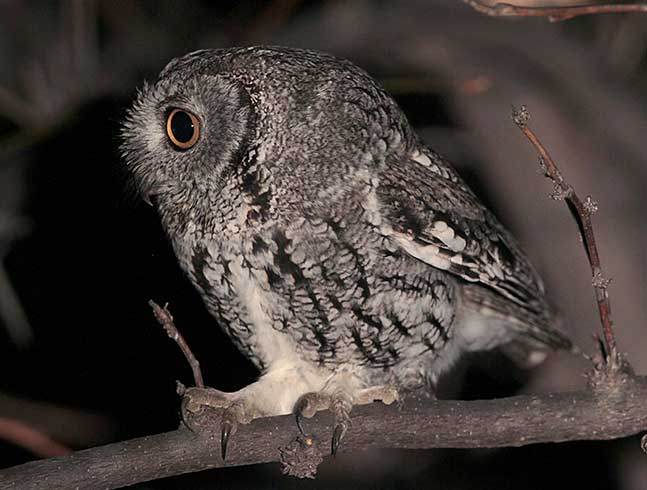
- Range: Permanent resident in British Columbia and the western USA.
- Length: 8.5 inches
- Wingspan: 20 inches
- Call: Has a “bouncing ball” song of short notes, “whup…whup..whu,whu,whu,whu,waa”.
The Western Screech Owl is a small brown or gray owl with ear tufts. It has “V”-shaped pale eyebrows, and some black on the edge of its face. This owl also has mottled upperparts with some white marks, and pale underparts with dark barring and streaks.
Males and females look similar but females are a bit larger. This species also has broad, rounded wings and a broad tail.
This nocturnal owl species lives in a wide variety of woodland and open habitats.
Key Identifications:
- Small, brownish or gray owl with ear tufts, a black border on the edge of its face, some dark streaks and markings on its underparts, and some white marks on its shoulder.
- Lives in many wooded and forest habitats.
- Nests in tree cavities and nest boxes.
- Watches from a perch before flying to catch small animals on the ground and from vegetation at night.
Rare Owls in Texas
Ferruginous Pygmy-Owl
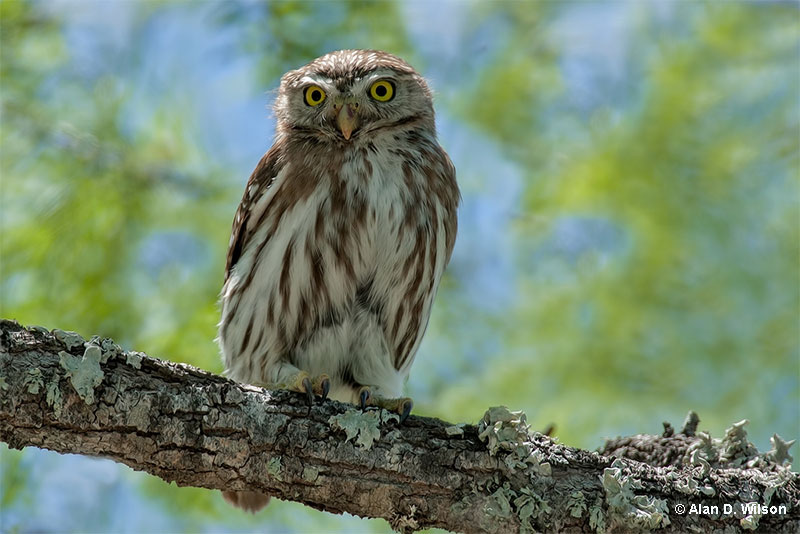
- Range: Permanent, rare resident in a few small areas of southern Arizona and southern Texas.
- Length: 6.75 inches
- Wingspan: 12 inches
- Call: (Write their distinctive call)
The Ferruginous Pygmy Owl is a small, gray and reddish-brown owl with two large black spots on the back of its head. It has a reddish tail with dark bars, fine white streaks on its crown, and brown streaks on pale underparts.
Both sexes look alike although females are a bit larger.
This rare diurnal owl species lives in desert and subtropical forest habitats.
Key Identifications:
- Small reddish-brown or brown and gray owl with streaks and two black marks on the back of its round head.
- Streaked underparts and a reddish tail.
- Lives in desert and subtropical forest habitats.
- Quickly flies out from a perch to catch small birds, bugs, and lizards.
Flammulated Owl
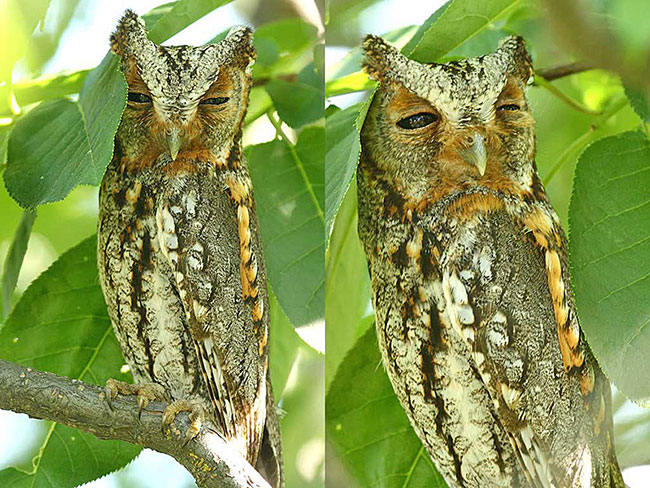
- Range: Summer resident in a small area of southern British Columbia, and in mountains in the western USA.
- Length: 6.75 inches
- Wingspan: 16 inches
- Call: Makes one, low-pitched “woot” call at regular, well-spaced intervals.
The Flammulated Owl is a small, thrush-sized owl with short ear tufts and dark eyes. It is mottled gray and reddish brown with pale eyebrows and some white spotting. This owl also has thick black streaks on mottled gray and white underparts.
Males and females look the same although females are a bit bigger. This species also has long wings and a short, broad tail.
Key Identifications:
- Small, mottled gray and reddish-brown owl with ear tufts and dark eyes.
- Breeds and winters in montane forest habitats.
- Nests in old woodpecker holes.
- Picks moths and other insects from foliage in flight, at night.
The Flammulated Owl breeds in Aspen, Ponderosa Pine, and other montane forest habitats in southern British Columbia, the western USA, and Mexico. It migrates to montane habitats in Mexico and Central America for the winter.
Northern Saw-whet Owl
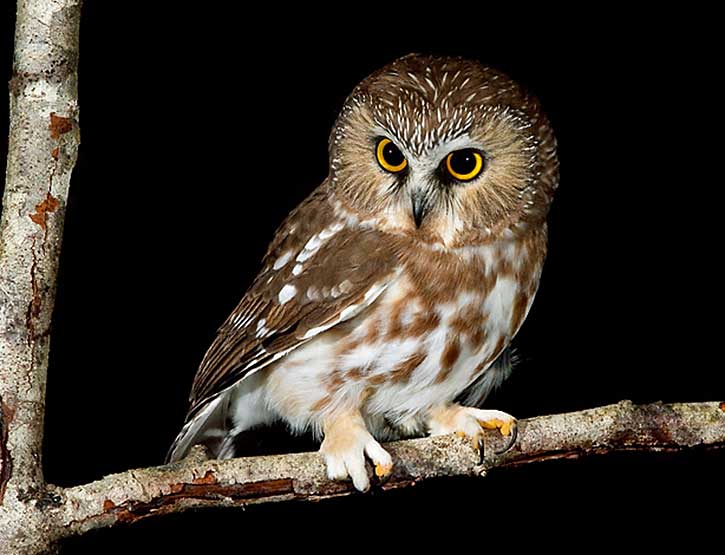
- Range: Lives in coniferous and mixed hardwood forests of Alaska, a large area of Canada, and parts of the northern and western USA.
- Length: 8 inches
- Wingspan: 17 inches
- Call: Makes a repeated tooting whistle call, over and over, “tu, tu, tu, tu, tu, tu, tu, tu, tu”.
The Northern Saw-whet Owl is a small, dark brown owl with a round head and brown streaks on white underparts. It also has some pale streaks on its head, a brown and white face, and some white spotting on its back.
Both sexes look the same but females are a bit larger. This species also has yellow eyes, a dark beak, longish, rounded wings, and a short, broad tail.
This nocturnal owl lives in forested habitats.
Key Identifications:
- Small, dark brown owl with a round head, broad white eyebrows, and thick dark streaks on pale underparts.
- Occurs in dense coniferous and mixed forest.
- Nests in old woodpecker holes and can use nest boxes.
- Swoops down to catch insects and small animals at night.
Spotted Owl
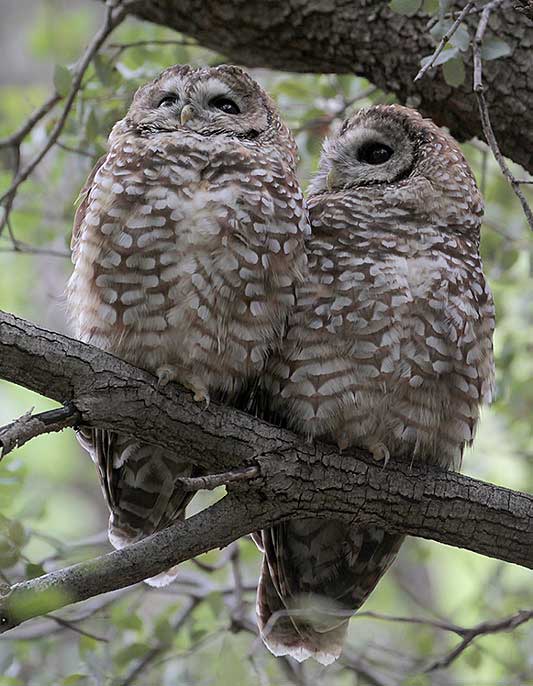
Photograph © Greg Lavaty
- Range: A permanent resident in the Pacific Northwest, the Sierra Nevada, and mountains in the southwestern USA.
- Length: 17.5 inches
- Wingspan: 40 inches
- Call: Makes abrupt, bark-like hoots, “whoot….oot oot..hoo…whew”.
The Spotted Owl is a medium-sized owl with a round head, dark eyes, and a narrow black border on its pale brown face. It also has dark brown upperparts with pale markings, and dark brown and white spotting on its underparts.
Males and females look the same but females are a bit larger. This species also has broad wings and dark bands on its broad tail.
This uncommon, nocturnal owl lives in mature coniferous and oak forests.
Key Identifications:
- Medium-sized, dark brown owl with white spotting on its back and flanks, and a round head.
- Lives in mature forest and woodlands.
- Nests in old raptor nests, in tree cavities, and on top of broken off trees.
- Watches from a perch before flying down to catch small animals on the ground, at night.
Related: All 15 Hawks in Texas
Northern Pygmy-Owl
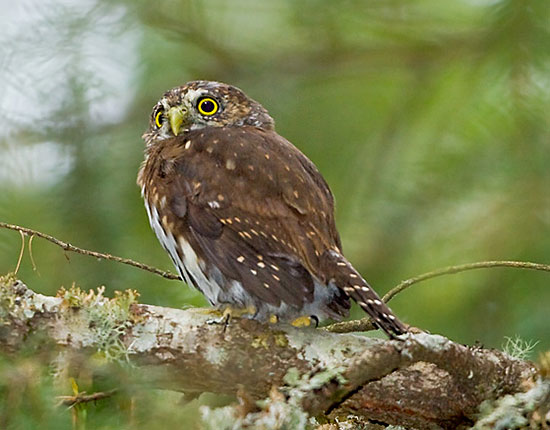
- Range: Permanent resident in the southern half of British Columbia and parts of Alberta, and in mountains and coastal forests of the western USA.
- Length: 6.75 inches
- Wingspan: 12 inches
- Call: Makes a single, well-spaced, whistled “Toot!” call.
The Northern Pygmy Owl is a small, grayish-brown owl with two large black marks on the back of its head. It also has small white spots on its head, breast, and flanks, a longish banded tail, and dark streaking below.
Both sexes of this small owl look the same but females are slightly larger than males.
This uncommon diurnal owl lives in oak and coniferous forest habitats.
Key Identifications:
- Small, dark brown owl with two black marks on the back of its round head, dark brown streaks on pale underparts, and longish dark tail with narrow white bands.
- Lives in forest habitats in western Canada and the western USA south to northern Central America.
- Nests in old woodpecker holes and natural tree cavities. It can also use nest boxes.
- Watches from a perch before flying out to catch small birds during the day.
Snowy Owl
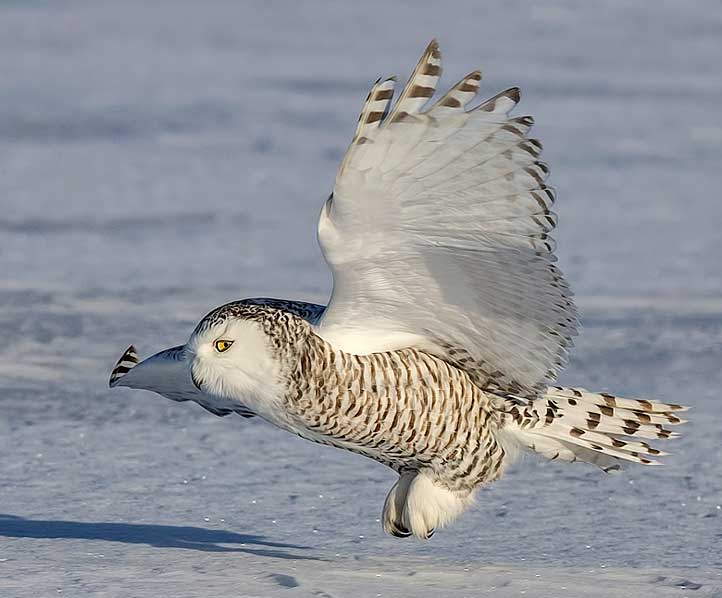
- Range: Summer resident in northern Alaska and northern Canada. It winters in Canada and the northern USA.
- Length: 23 inches
- Wingspan: 52 inches
- Call: Usually quiet but occasionally makes a low, gruff call, “whew…whuh”.
The Snowy Owl is a big, mostly white owl with a round head and yellow eyes. Some males are mostly white but most have some small dark marks. Females and young birds have white faces and varying degrees of black barring.
Females are a bit larger than males and have more black markings than males. Snowy Owls also have long, broad wings and a broad tail.
This owl species is active during the day and lives in wide-open habitats.
Key Identifications:
- Big white owl with a round head, and varying degrees of black or dark gray barring and spots.
- Lives in tundra and winters in wide open habitats.
- Nests on the ground, on elevated spots in Arctic tundra.
- Watches from a perch and glides low to catch small animals on the ground.
Stygian Owl
- Range: A permanent resident in various parts of Mexico and the Caribbean south to South America. A rare vagrant to southern Texas.
- Length: 16.5 inches
- Wingspan: 38 inches
- Call: Makes a brief, high-pitched call and a deep, single noted hoot call repeated at long intervals, “hoot…………..hoot”.
The Stygian Owl is a medium-sized, dark, slender owl with ear tufts and yellow eyes. It has a white mark on its forehead, a blackish face, and dark streaks and barring on pale underparts. This owl also has long wings.
Males and females look similar but females are a bit larger. This species also has buff on its belly and thighs, and large feet with long talons.
This vagrant owl lives in a variety of tropical woodland habitats.
Key Identifications:
- Large, blackish, slender owl with ear tufts and a buff belly.
- A tropical species of coniferous and semi-open woodlands.
- Can nest on the ground or in an old raptor nest.
- Watches from a perch before quickly flying to catch roosting birds and other small animals at night.
Mottled Owl
- Range: A Mexican and neotropical species. Rare vagrant in the lower Rio Grande Valley of Texas.
- Length: 12 inches
- Wingspan: 34 inches
- Call: Makes two, gruff, well-spaced barking sounds, “Whoof!….wuf”.
The Mottled Owl is a smallish to medium-sized owl with a round head, dark eyes, and a yellowish beak. It is dark brown above and on its head, and has pale eyebrows. It also has buff underparts with dark brown streaks.
Male and female Mottled Owls look the same but females are much larger. They also have broad wings and some pale bands on a broad, medium-length tail.
This nocturnal owl lives in tropical forest patches and other woodland habitats.
Key Identifications:
- Smallish to medium-sized dark brown owl with a round head, dark eyes, and dark streaks on pale underparts.
- Occurs in southern Texas as a rare vagrant.
- Nests in natural tree cavities and can also use nest boxes.
- Watches from a perch before swooping down to catch small animals on the ground, at night.
Related: Texas State Bird – All You Need To Know
Owls in Texas – Frequently Asked Questions
What is the most common owl in Texas?
The most common owl in Texas is the Great Horned Owl.
What type of owl lives in Texas?
Many types of owls live in Texas. There are Great Horned Owls, Barred Owls, seven other common species, and eight rare species of owls in Texas.
Are there a lot of owls in Texas?
Yes, there are a lot of owls in Texas. Owls live in every part of the state.
Are owls protected in Texas?
Yes, owls are protected in Texas by state and federal laws.
What do Texas owls eat?
Texas owls eat everything from bugs to rodents, rabbits, bats, reptiles, and birds.
See more: Common birds in Texas | Owls in Texas | Ducks in Texas | Hummingbirds in Texas


